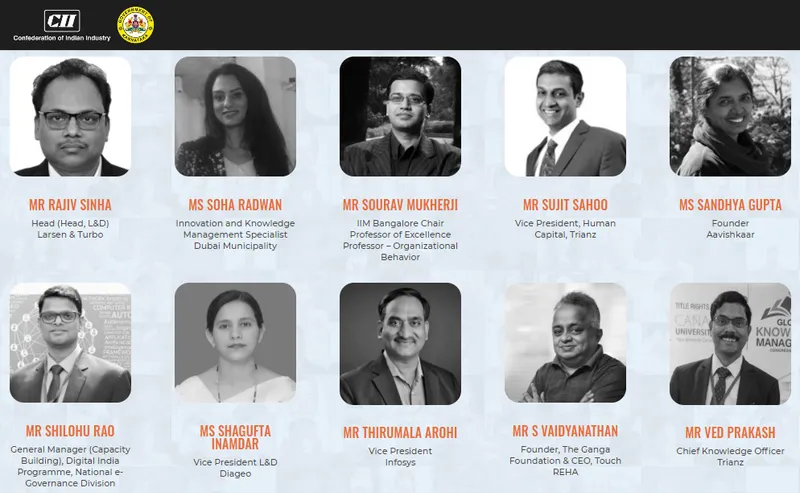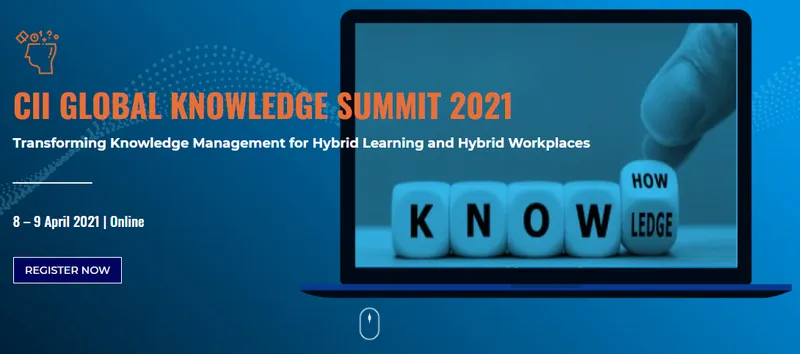Digital impacts on learning and education: CII Global Summit showcases future of knowledge work
In this preview article on CII’s upcoming Knowledge Summit, we share insights on trends and impacts of remote learning.
CII’s annual Global Knowledge Summit is being held entirely online on April 8-9 this week. The theme of the 16th summit is Transforming Knowledge Management for Hybrid Learning and Hybrid Workplaces.
As media partner for the Knowledge Summits, see YourStory’s coverage of the editions from 2021, 2020, and 2019, and sessions takeaways from the Bangalore K-Community meetups.
See also our profiles of MIKE (Most Innovative Knowledge Enterprise) award winners EY, Tata Steel, Cognizant Technology Solutions, Afcons Infrastructure, Petroleum Development Oman, BINUS University, and Mobarakeh Steel Company.
Pandemic era
Three speakers share examples and experiences of remote learning during the pandemic in the school and corporate contexts. In a chat with YourStory, entrepreneur and educator Ankit Khandelwal cites a startup that helped a big Western city use AI-based training for nursing students in domains like intensive care, and bridge the critical skills gap in time.
“Thanks to technology, within a very short span of time, many organisations were able to quickly move from in-person learning sessions to remote learning sessions,” observes Dr J. Jagatheesh Jayanand, Head, Bosch Training Centre.
“While necessity was the push behind the intervention, the pace at which organisations were able to do so amazed me. I had the opportunity of seeing and doing this is in different industry segments,” he explains, drawing on examples from within the Bosch Group and with a leading IT major.
Though there were some questions about whether remote learning could actually work, ways to effectively share knowledge were discovered along the way. Knowledge sharers and learners responded effectively, lessons learnt were huge, and the outcome was positive, Jayanand recalls.
Many e-learning companies also scaled up to address market needs with respect to infrastructure and content. “We had an opportunity to collaborate with many organisations who helped us to achieve effectiveness through remote learning,” he adds.
“The pandemic has been a very difficult situation, but it has also been a time for out-of-the-box innovation,” explains Sandhya Gupta, Founder of Aavishkaar, a learning solutions provider for schools, based in Himachal Pradesh.
Because everything moved to online engagement, all communication and content matter got documented. “This meant all our content was prepared in a presentation-ready format. Every team member's learning shifted to high gear as they learnt how to use new platforms,” she adds.
“Earlier, we tried to choose communities that were geographically closer to our location to reduce travel time and overhead cost. This barrier was fully broken,” Sandhya says.
“We become the training lead of a Science and Math Collective of 14 grassroots organisations that work with adolescent girls of under-represented communities,” she recalls. The year-long programme effectively helped attendees with hands-on understanding, and more such programmes have been spun out this year.
Though schools were closed during lockdowns, Aavishkaar trained 2,000 government school teachers in the state. “We also got the opportunity to work with older students who were able to meet young children and wanted to help them out,” Sandhya adds.
These “Aspiring Teachers” had a special year-long online programme designed for them, where they learnt online and taught other kids. “This has helped us start a brand new Primary Math Educators Programme,” she explains.
Aavishkar has a strong focus on underrepresented communities, especially girls. “Our focus has always been discovery-based Thinking Classrooms for our students. We decided to keep the same focus in the online platform with fewer hours and were able to implement it successfully,” Sandhya proudly says.

Advantages
Despite challenges like small device size and less direct eye contact, remote learning can be made effective, according to Sandhya. “These challenges become the boundary conditions around which we need to make an effective, engaging and efficient class. This calls for strength of facilitation and purposeful designing,” she says.
Traditional physical training has to factor in costs and time of attendee travel, as well as hotel and food expenses. “Remote learning gives the advantage of the reduced overhead cost of training, and a chance to provide even more opportunities for capacity building of the team,” she adds.
“Remote learning also provides the opportunity to spread out a training to several short sessions over days, rather than completing everything in one go,” Sandhya observes.
For many trainings, this is a very effective model. “It provides that reflective space between sessions to understand the content and come back with questions,” she explains.
“Unlike in-person class, online sessions always need a presentation which forces every presenter to plan. This results in improving the effectiveness of the session,” she adds.
“Online sessions de-front the class. There is no front bencher or back bencher. The space becomes more democratic. We can collect multiple answers without revealing any answers to others. We can communicate with the participants without disturbing others’ thoughts,” Sandhya says.
The remote mode allows learning at one’s own place and time. “It brings in a lot of self-discipline which gets the learner to own the learning to a good extent. Organisations have started to work towards getting the learner at the centre of the experience,” observes Jayanand of Bosch.
“Remote learning brings convenience, flexibility, and personalisation as compared to the current top-down approach of training,” Ankit Khandelwal observes. Fast learners can finish more quickly, and slow learners will also not be left out.
“The same can be said about working mothers who can finish a course in many sessions. Remote learning offers a way for employees to upskill their valuable employees in a better way,” he observes.
“Remote learning has the potential to improve the overall productivities of employees. Engaging and relevant content can yield high results in a short amount of time,” he says. Organisations should carefully select the traditional or remote approach they need based on their corporate work culture, he advises.
Going ahead, AI-based models will be able to predict the specific weakness areas of individual learners. “This will help to get more focus, thus overall improving the learning outcome,” Ankit suggests.

Challenges
At the same time, there are challenges as well with remote learning with respect to hard and soft parameters, as the speakers identify.
“In remote learning, there is no tea time conversation between sessions. There is no catching up with How have you been? or Which college did your daughter decide to go to?, and other fun stuff like this,” Sandhya of Aavishkaar observes.
There are no larger-than-self blackboards available to the participants. “On the contrary, they would be watching in their small smartphone screen with top and bottom parts covered with some writing,” she says.
Some will lose part of the conversation because the internet connection was weak, or the family needed attention, or someone is talking in the background. “It may not be possible to extend conversations as the participants may have limited data packs,” Sandhya cautions.
“There is no such thing as eye contact in the internet world. You may not have the luxury of even reading facial expressions as the videos might be off, or the screen is covered with PowerPoint and you can't see many faces,” she laments.
Early challenges in the unchartered territory of remote learning were understanding technology operations, engagement models, and the increased cognitive load, recalls Jayanand of Bosch.
“General content cannot be useful for everyone; customisation is necessary,” Ankit Khandelwal observes. It is also a challenge to prevent cheating when assessing the outcome in remote learning.
Making learning engaging will also be an issue. He asks: “In the age of distraction, how do you keep learners engaged for a longer duration?”
“A huge cultural shift is needed for this type of learning. Many people are not comfortable in learning through an app or computer program, and prefer the old classroom approach,” Ankit observes. They will need to be convinced to shift to remote learning.
“Soft-skill development through remote learning is still in the early stages of development. Can the skills like teamwork, public speaking, and leadership be effectively developed via remote learning? This is going to a big question,” Ankit adds.

The New Normal
Many aspects of remote learning will continue to be in use even after the pandemic eases and classroom teaching resumes, according to the speakers.
“If the majority of the workforce is going to be in the office similar to the pre-COVID level, then I do see demand declining. However, if the large-scale hybrid working model becomes a new normal, then remote learning will stay at the current level for a short time and increase in the future,” Ankit Khandelwal predicts.
“As we move out of the pandemic, the industry will take the best of both modes and blend them. Any learning interventions will now have a remote or digital component that would take care of the pre-learning parts, for example,” Jayanand of Bosch explains.
Trust in remote learning and its effectiveness have increased during the period of pandemic. A right confluence of culture and technology with the learner at the centre is visible in the design of the Bosch Learning Campus, he explains.
“We will see remote learning increasing. We have accepted it as a way of life. We not only use it for professional meetings, but also for meeting our families and friends. Online saves money. There is hardly any overhead,” Sandhya of Aavishkaar emphasises.
“We can do remote learning from anywhere. Our geographical location is a non-issue in remote learning which gives a lot of flexibility,” she adds.
“Remote learning is here to stay. One year of work from home has given us enough time to adapt to this new reality, and optimise the process to make it effective. It has given us an opportunity to explore new training models,” Sandhya affirms.

Trends
Jayanand of Bosch identifies the rise of VR in learning as a major trend. “With remote learning, there is a feeling in the learner and knowledge sharer that the element of feel is missing. VR can help solve this problem to some extent,” he explains.
There will more focus on RoI approaches, beyond the number of learning sessions conducted to actual impacts. There will be more attention on the experience for the learner and knowledge sharer, and reduced cognitive load.
Another trend Jayananad identifies is co-learning. “Collaboration is going to increase big time in the learning space. As organisations become more open, even competitors could get together to learn a technology or a methodology,” he suggests.
“This is a very healthy situation to be in, where learning doesn’t have boundaries and we learn together to solve a larger problem faster and easier,” he affirms.
“There will be an increased focus on making content more engaging and user-centered, through storytelling or gamification. Some corporations have already started training their employees in this way,” Ankit Khandelwal observes.
“Corporations may start developing their own content and certifications to fulfil their needs instead of relying on university education. We will see a rise in "menu-based" approaches in learning,” he predicts.
Sandhya of Aavishkaar foresees more training courses being offered online. There will be many more implementations like Khan Academy coming up as well.
“The myth of going to school or college as the only way of learning has already taken a hit. Learners will take ownership of their learning and look for sources independent of school,” she predicts.

Tips and advice
The speakers also offer tips to educators and corporate leaders on the mindsets and skillsets for remote learning.
“Beyond content delivery, to get depth through human connection and build relationships, one must take time to think and ponder with learning partners, and brainstorm solutions systematically,” Sandhya of Aavishkaar advises.
“Remote learning is truly here to stay. The pandemic has provided this unique opportunity to change mindsets about the way learning is possible. It's our job to figure out how we can give the best of both worlds to our learning community,” she suggests.
“Hybrid learning produced some amazing results, though it was largely related to university education. The pandemic has made everything remote and we have yet to see any good studies on the impact of merging these two types of learning in a corporate setting,” Ankit Khandelwal observes.
Corporates should assess their culture, requirements, employee engagement, and market needs before choosing their learning track. “Every type of training has its own pros and cons,” he adds.
“Keep a right balance and blend between in-person learning and remote learning as the pandemic slows down, even though there may be temptation to shift back to the earlier mode,” Jayanand of Bosch advises. This blend will do a lot of good to learners and knowledge sharers.
“Be ready for the switch anytime, in case the next wave of the pandemic or some other interruption emerges. Proactively working on infrastructure and people readiness is the key here,” he cautions.
“Keep the collaboration quotient up,” Jayanand emphasises, drawing on his own experience of getting support from other industry colleagues. The urgency has led even competitors to help one another.
“In short, we started to sink our self-centered needs, and collaborate. Let us continue that spirit,” he signs off.
Edited by Saheli Sen Gupta












